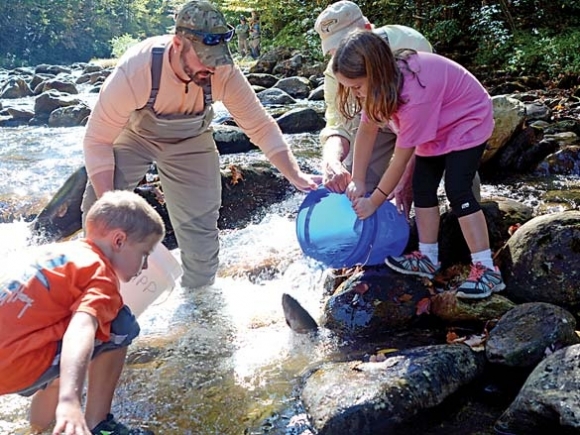Stocking the Pigeon: Trout stocking a team effort in Haywood

It’s a sunny Friday morning on the Pigeon River when the bucket brigade assembles, five-gallon containers in hand. The stock truck has just arrived, making its way up windy U.S. 276 and down the equally squirrely N.C. 215, tanks loaded with fish and water.
A pair of fish culturists from the N.C. Wildlife Resources Commission stands atop the truck as a line of bucket-bearers forms leading up to it, and the work begins. Each bucket received a splash of water and a dollop of flipping, fighting trout — rainbow, brown and brook all mixed together in one writhing mass.
There’s a splash zone around the truck as the trout fling sprinkles of water on their way into the buckets, occasionally protesting the transfer successfully enough to fling themselves away from the bucket and onto the ground, where bucket brigade members promptly grab the twisting creatures and replace them in the water-filled buckets, where they can breathe once more.
It’s trout stocking season in Western North Carolina, and the Wildlife Commission truck held 1,425 pounds — 2,400 individual fish — of trout to go in the West Fork Pigeon River upstream of Lake Logan near the Burnett Siding Baptist Church and Cold Mountain Shooting Range. The shipment is one of many that the Wildlife Commission will make over the course of the coming spring and fall to boost success of anglers in these Delayed Harvest waters. Last year, the Wildlife Commission stocked 240,000 pounds of fish in the WNC counties covered by the Bobby N. Setzer Fish Hatchery in Brevard — the area includes all of District 9 from Buncombe and Polk counties west, as well as a few bodies of water in adjoining District 8.

“What this does is it makes the fishing experience so much better,” said Ron Gaddy, a member of the Trout Unlimited Cataloochee Chapter organizing the bucket brigade. “It’s not just about fishing. It’s about our economy.”
Related Items
Anglers will travel a long way to cast their lines in premier trout waters, and when they do they spend money on fishing supplies, meals out, hotel rooms and a thousand other things. A study released this year found that 149,000 trout anglers fished 1.6 million days in North Carolina during 2014, contributing $383 million to the state’s economy. The western counties contain some of the best trout fishing in the Southeast, and when chances of success go up — as is the case when waters are stocked — so does the attractiveness to out-of-town anglers.
The stretch of the Pigeon River that was stocked last week is designated as a Delayed Harvest waterway, meaning that anglers are allowed to keep their catch only during the summer months from June 1 to Oct. 1. The rest of the year, the river is catch-and-release only in order to keep the waters from being depleted too quickly. However, Gaddy said, he and many other trout anglers would like to see some waters in Haywood County designated as catch-and-release only all year long.
“Other counties have made designated waters catch-and-release year-round,” he said. “That would provide better fishing through the winter months.”
Jackson, Buncombe, Burke, McDowell, Watauga, Avery, Transylvania, Ashe and Yancey counties all have waters with this designation.
For some of those gathered that Friday, however, the event was about more than improving angler success. It was a chance to see fish up close and to experience the beauty of Haywood County’s mountains firsthand.
That’s what led Ann Upp to bring her three grandchildren and their father out to lend a hand. The stocking, she said, is just an opportunity “for them to understand about the life cycle of fish, and just being out in nature and marveling at God’s creation and just enjoying the beauty out here.”
The kids — Maddy Upp, 9, and twins Molly and Jameson Upp, 7, — certainly seemed to be achieving that goal of enjoyment. The kids dutifully grabbed buckets, just like their adult counterparts, and helped lug them full of splashing fish down to the river, where they tipped them out in the main current and watched the trout swim away.
Ninety-six percent of the fish released that day were about 10 inches, but 4 percent were part of the Wildlife Commission’s big fish program, measuring 14 inches and up — several were as long as 21 inches. The kids got a chance to help with the release of two of those big fish, the first one of which was so big it got a bucket all to itself. Their dad helped them carry the bucket out on the large stones that rose from the shallower portions of the riverbed and dump the fish out into the free-flowing water. There was a bit of a scuffle when the fish managed to divert itself into a still pool surrounded by rocks, but team Upp corralled it back to the main current once more.
The second fish made its appearance later in the morning, landing in a bucket hefted by their father.
“He’s beautiful!” Maddy exclaimed as her dad picked the fish up, but when asked whether she wanted to hold it she lifted up her hands and shook her head no.

According to TU Cataloochee President Tom Thomas, this hands-on stocking method is a more fish-friendly way to get the fish in the river than dumping them all out in one spot. The buckets allow the fish to be distributed throughout the river, increasing their chance of survival once released. And with 32 volunteers, the boost in manpower is a big help to the Wildlife Commission. The Oct. 6 stocking drew a record number of volunteers, more than double the typical number of 15 or so — Thomas attributed the heightened interest to exposure in publications such as The Smoky Mountain News.
Eventually, the stock truck emptied out and there was no more work to be done. But that doesn’t mean everyone turned around and went home. Many of the 32 people who had come to help had also come to fish.
“It’s exciting, knowing we’re going to go back and fish it,” Jenny Cornwell, 24, of Charlotte, said of participating in the stocking. She and her friend Megan Helms, also a 24-year-old from Charlotte, come to the mountains multiple times each month to fish the rivers, and they were excited to get started.
“I really appreciate these guys coming out and helping us,” said Jillian Osbourne, a fish culturist for the Wildlife Commission as the morning wrapped up. “It is fantastic. They do a great job.”
By the numbers
• 2,400 pounds of fish stocked in the Pigeon River Oct. 6
• 55 percent rainbow trout, 30 percent brook trout, 15 percent brown trout stocked Oct. 6
• 96 percent 10-inch fish stocked Oct. 6, with remaining fish 14 inches or more
• 240,000 pounds stocked by the Bobby N. Setzer Fish Hatchery in 2016
Figures provided by Adam Moticak, hatchery supervisor









